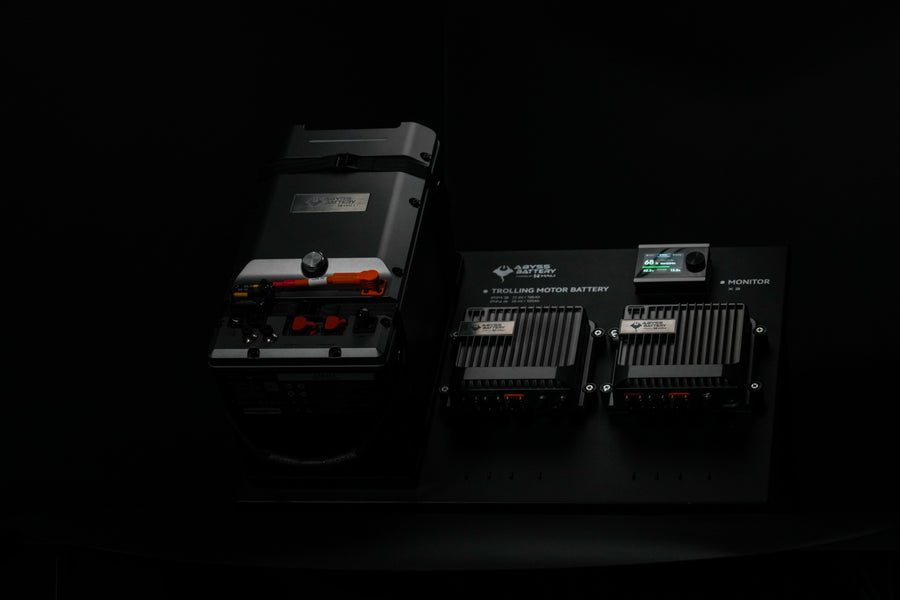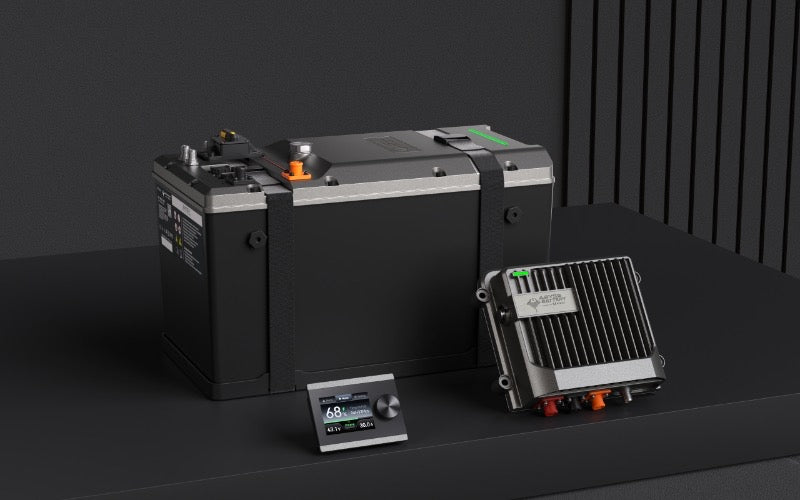How To Charge a Deep-Cycle Marine Battery Properly

Avid boaters understand the importance of having a reliable and long-lasting battery while out on the water. A properly charged deep-cycle marine battery can make all the difference in ensuring a boat’s electrical systems function smoothly and efficiently for the duration of the trip. A poorly charged cell, on the other hand, can leave you stranded in the water or without essential functions.
In this guide, we’ll cover everything you need to know about properly charging a deep-cycle marine battery, from understanding the basics of these specialized batteries to using the proper charger. This article will provide you with all the information you need to keep your boat running smoothly.
Understanding Deep-Cycle Marine Batteries
Before we dive into how to properly charge a deep-cycle marine battery, we need to explain what makes these batteries different from your standard starter battery. While both offer solutions for storing and using energy, deep-cycle marine batteries are for long, slow discharges and recharges, making them ideal for long outings on the water.
While a starter battery provides a short burst of power to get the engine running, deep-cycle marine batteries continuously supply lower amounts of power over an extended period. They’re perfect for powering the various electrical systems on your boat, such as lights, radios, and trolling motors.
Why Proper Charging Is Important
A deep-cycle marine battery is a significant investment, and taking care of it through regular charging will ensure its longevity. A well-charged battery provides reliable power while out on the water, reduces the risk of damage, and increases its overall lifespan. Avid boaters who want to protect their investments must, therefore, abide by proper manufacturer recommendations to ensure their cell lasts.
Improper charging can lead to sulfation, a build-up of lead sulfate crystals on the battery’s plates. This can significantly decrease the battery’s capacity and performance over time. Sulfation is also one of the leading causes of premature battery failure. So you’ll want to understand the importance of proper charging and learn how to do it correctly to get the most life out of your deep-cycle marine battery.
Step-by-Step: How To Charge a Deep-cycle Marine Battery
There are many things to remember when it comes time to charge your deep-cycle marine battery. Remember, each step is essential to ensure your cell stays in good condition and lasts as long as possible.
1. Gather Your Materials
Before you begin charging, make sure you have all the necessary materials on hand. This includes a deep-cycle marine battery charger and a clean cloth or towel. Make sure the charger is compatible with your battery’s voltage and type. Safety glasses and gloves are optional, but they prevent sparks from causing injury.
2. Prepare the Battery
Once you’ve got everything you need, you can get the battery ready for charging. First, turn off your boat’s main power switch to avoid any electrical accidents while working on the battery. Then, use a clean cloth or towel to wipe down the battery’s terminals to remove any corrosion or dirt. You can also apply terminal grease to improve the connection.
3. Connect the Charger
Next, you can connect the charger. Identify the positive and negative terminals on your battery, usually marked with a plus (+) and minus (-) sign. Ensure you’ve properly connected the charger’s positive clamp to the positive terminal and the negative clamp to the negative terminal. Be careful while doing this, as doing it in the wrong order can cause irreversible damage to the cell.
4. Set the Charging Rate
Most deep-cycle marine battery chargers have multiple charge rates, typically ranging from 2–10 amps. Consult your battery’s manual to determine the appropriate charging rate for your specific battery. Too high a current can fry the battery’s components. You should always charge at a lower amperage for a longer period, as this prevents overheating and prolongs the battery’s life.
5. Plug In and Start Charging
Once you connect everything properly, you can plug in the charger. Some models may have a “start” button or switch, while others will begin charging automatically. In any case, don’t let the charger run on its own for too long. Monitor the battery’s voltage and temperature periodically to ensure it doesn’t exceed the recommended levels.
6. Let the Charger Complete Its Cycle
Once fully charged, your deep-cycle marine battery should read between 12.4 and 12.7 volts, depending on the type of cell. Some chargers may have a “float” or “maintenance” mode that will keep the battery fully charged. If not, unplug the charger after completing the cycle. Remember to keep the battery and charger in a cool, dry location where it won’t overheat or get wet.
7. Disconnect and Clean Up
Once you fully charge your battery, disconnect the charger’s clamps in the reverse order you connected them with the negative terminal first. Once you disconnect it, double-check to ensure it’s in good working order and fully charged. Remember to turn your boat’s main power switch back on and use a clean cloth or towel to wipe down the terminals again.
Additional Tips for Maintaining Your Deep-Cycle Marine Battery
These are just a few of the things to remember when charging your deep-cycle marine battery. Here are a few things to keep in mind:
- Always use a deep-cycle marine battery charger specifically designed for lead-acid batteries. Avoid using car chargers, as their higher voltage can damage your battery.
- If possible, charge your battery in a well-ventilated area to avoid the build-up of explosive hydrogen gas.
- Avoid charging your battery in extreme temperatures, as this can affect its performance and lifespan.
- Regularly check and clean your battery’s terminals to prevent corrosion, which can inhibit proper charging.
With these tips, you should have everything you need to ensure your deep-cycle battery lasts. Whether you’re using a simple portable lead-acid charger or an onboard lithium battery charger, learning the process and doing it right will help you protect your investment and enjoy your time to the fullest.
Charge Up Before Your Next Adventure
Properly charging your deep-cycle marine battery is crucial for maintaining reliable power on your boat. By following these simple steps and tips, you can ensure yours continues to operate efficiently. So before your next boating adventure, give your battery the charge it needs!





Good day. This is Sanzi from TOPBAND. I visited your website and found you are selling batteries. TOPBAND is a public group company worth nearly 2 billion USD and has 18 years experience manufacturing batteries. Especially for the marine and RV batteries, we are the top 5 export factory in China. And we have a factroy in Mexico. I wonder if we could have a chance to communicate and become your supplier.
Could you transfer my message to someone related to purchase? Thank you.
Is there cheap deep cell Marina batteries out there that you can buy affordable
Leave a comment